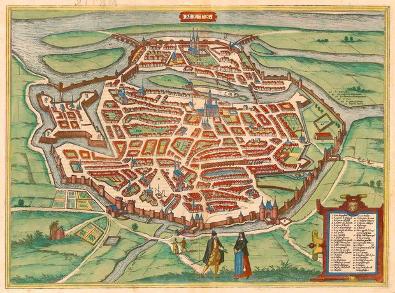THE PALACE OF HAUTE PIERRE
Home of the Yorkist Court in Exile

Map of Metz published in 1593 by Braun & Hogenberg
On the 2nd of September 1514 Richard de la Pole, the self-styled Duke of Suffolk and last Yorkist heir to the throne of England, was forced to seek refuge from his Tudor enemies in the free city of Metz. For two years the 'Blanche Rose' lodged in the houses of Metz's prominent citizens, a situation which caused a great deal of friction between Richard and his hosts, but eventually he was allowed to lease a ruined abbey near the city's cathedral on condition he repaired the building at his own expense.
The mouldering abbey, which had been destroyed during a siege of the city fifty years earlier, was situated on the higher ground that stretched along the south bank of the River Moselle so Richard named his new home Haute Pierre - the High Rock.
Fortunately, the exiled Englishman had plenty of gold in his pockets, thanks to the handsome pensions he had been granted by the kings of Hungary and France, and over the next year he transformed the derelict abbey into a sumptuous palace worthy of a prince.
Richard's palace of Haute Pierre survived until the late 1700s when it was demolished to make way for a new governor's residence. This building, which still stands today, now serves Metz as the city's law courts but the name of Richard's palace lives on in the street name Rue Haute Pierre.